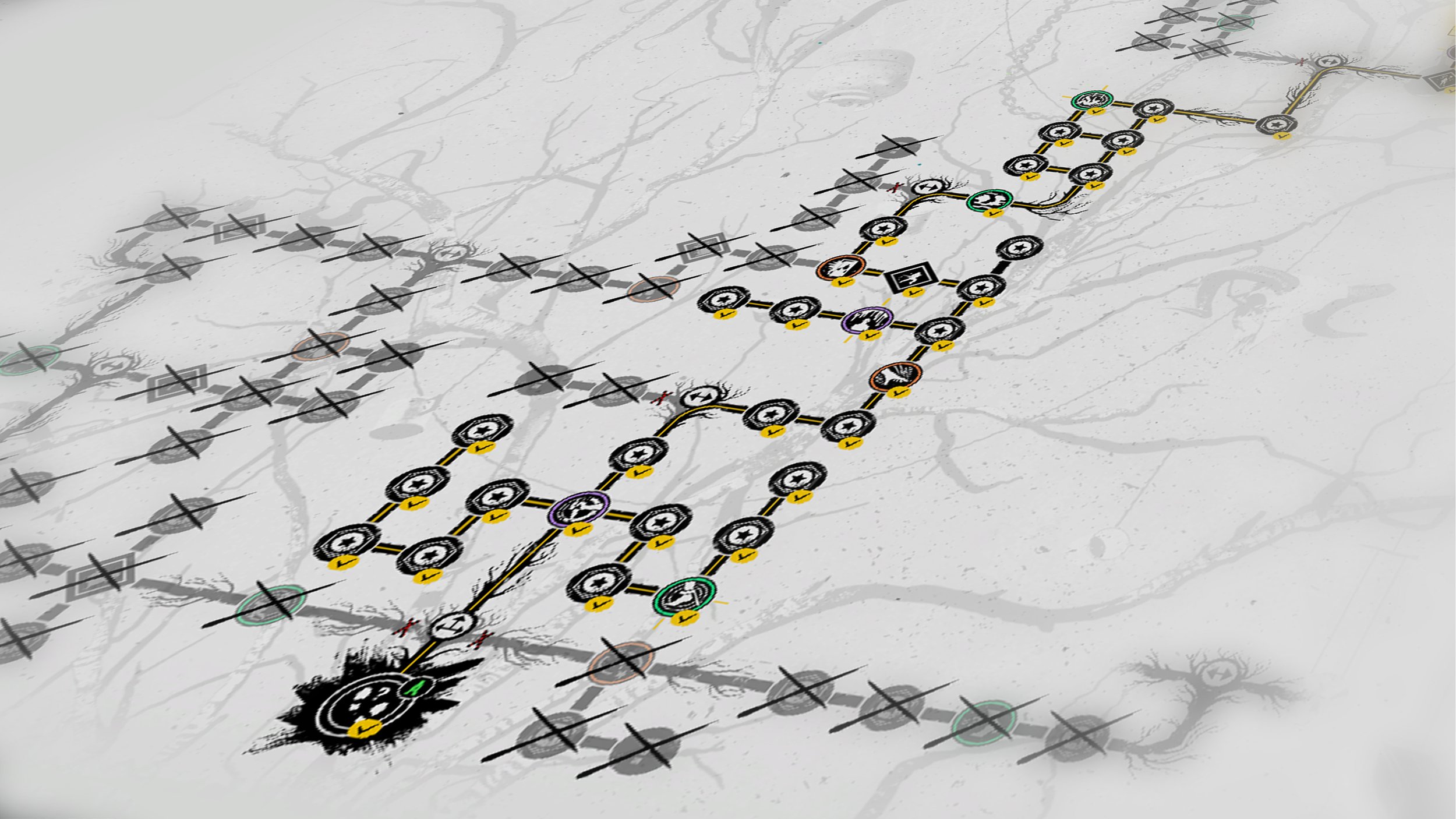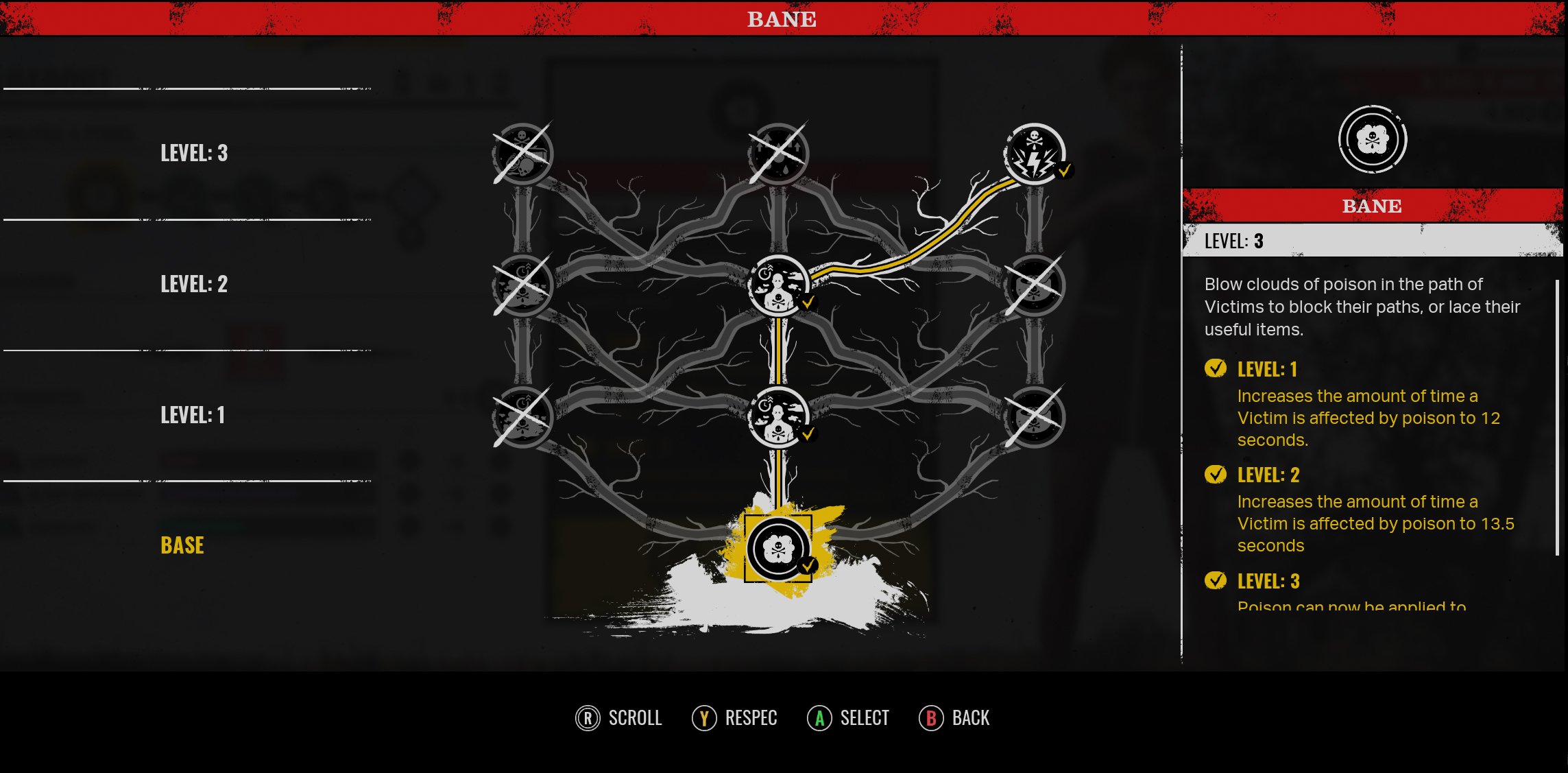Metagame Explained
We’ve detailed Family and Victim attributes and abilities and now it’s time to dive into the metagame. Read on in the Hub to know how it works.
We know that you are excited to play The Texas Chain Saw Massacre. As promised, we’ve broken down what the metagame is and how it works. We want to ensure that players have a great time getting their chainsaw on but first, let’s tell you how to chainsaw. Everything from leveling up to exploring the Skill Tree will be explained below.
Where do you start?
Whether they are a member of The Family or a Victim, each character comes with an ability, as well as various Perks and attributes. These can all be saved into loadouts. There will be 5 slots available per character for customizable loadouts. This means that there can be different loadouts for different gameplay styles. We want each player to bring their own flair through their loadouts to make for intense, fun, and interesting gameplay during a match.
Abilities will be the core of each character’s uniqueness. This ties to their roles, strengths, and weaknesses. Every ability is able to be upgraded in the Skill Tree (we will go into more detail further down).
Note: There are abilities that can be equipped by Family members called Grandpa’s abilities. When Family members feed Grandpa blood they can:
Raise his power level
Pave the way for Grandpa to unlock more abilities
Use an unlocked ability in a special slot on the character loadout screen
This means that coordination will be vital with other Family members. Remember Grandpa will be much happier when The Family plays well together.
Perks
Perks can modify a character to give them a certain advantage in a specific area or skill. All Perks can be chosen and equipped in the loadout menu. There are 3 MAX Perks per loadout, with a total of 5 loadouts. This means that each character has the potential to leverage a total of 15 Perks from within their loadouts.
You can access Perk selections through a character’s Skill Tree. Only Perks that have been unlocked in the Skill Tree can be equipped on the loadout screen. Each character has different strengths and weaknesses based on their key attributes.
Increasing the level of a Perk requires that you equip it in the loadout menu. Perks will level up as you play. Perks can range from recovering stamina after not being hurt to increasing stamina in hiding spots or shadows. These Perks will vary depending on how you build your loadout and which character you are playing. Some fun Perks to keep an eye out for will be those that aid in not only making your character stronger but also helps The Family or other Victims you’re playing with.
Loadout Customization Screen
Perks of note for Victims:
Rally Leader
When you rally the team by helping other Victims, you and your team will recover from being incapacitated faster
Parting Gift
When one Victim escapes, all Family Members will be highlighted for the Perk holder
Bounce Back Better
Healing Items you use are more effective
Perks of note for Family:
Unrelenting
This increases your Endurance
Tracker Tagged
Hitting a Victim will highlight them for all Family Members
Exterior Alarms
When active, all critical doors and gates are highlighted if they’re opened
Attributes
Attributes are Toughness, Endurance, Strength, Proficiency, and Stealth. These attributes can be highlighted in the menu and can be adjusted with unlocked attribute points. Family members each have their own special abilities and attributes with Savagery, Blood Harvesting, and Endurance.
Players can unlock attribute points through a character’s Skill Tree. You can use attribute points to compensate for weaknesses or boost strengths.
Attribute points allow for customization to any and all characters. Different game play styles can be made through the allocation of attribute points through a character’s Skill Tree. This means that not all loadouts will work from character to character.
For instance, many players are excited to play as Connie for her Focused ability. She can pick locks a whole lot faster than her friends but it’s at the cost of her stamina and Family proximity warnings. One player can choose to put most of their attribute points to Connie’s Endurance to make up for her stamina loss. Another player can choose to not buff her stamina at all and add as many attribute points to Proficiency. There are numerous ways to play a singular character and whenever a player wants, they can respec their character Skill Trees to build a new way to play.
For further details about Victims, you can read about their individual special Abilities and Attributes here. For more details about Family members, you can read all about them here.
How to Level Up
Players can level up by earning experience points (XP). Players can gain XP for actions made during a match. The more important an action is, the more XP players can earn. XP does not only level up your account and character but also unlocks rewards and gives players Skill Points. These can be used on your character’s Skill Tree.
Here are some of the actions that can earn you XP:
Winning a close encounter
Turning the generator on
Escaping/dismantling traps
Healing your teammates.
Perks and abilities that are equipped during matches will level up. This means that, over time, it’ll get stronger the more you play. Another way to level up the character you're playing as will be based on the amount of Skill Points used in a character’s Skill Tree.
Every playable character has a maximum of 10 levels to complete. A player’s level and character’s level are two different aspects of the metagame. Your account level ranks up with the XP you earn. Your character’s level ranks up through your Skill Tree unlocks. By looking at both player and character level, you will be able to discern how dangerous/elusive they could be in a match.
Your player progression will always be tracked through the Progression tab on the Main Menu. It will break down all playable characters and what level you’ve reached with them. In this menu, you’ll be able to see all of your stats, ranging from how many kills you’ve got to how much blood you’ve lost. That way, you can find the exact stat to brag about when you sit at the dinner table with the Family.
It is highly recommended that you play as both Family members and Victims in order to learn the strengths and weaknesses of each character and side. This way, you can use that knowledge to your advantage when building your loadouts and unlocking Skill Tree nodes.
The Ability Unlock Tree
Now that the bases are covered, let’s dive into the ability unlock tree where the metagame picks up.
Every character's special ability can be leveled up. The default setting for each ability is the base level and each has 4 levels they can progress through. From the first level, you can add a bonus to an ability to make it more effective. Note that bonuses stack on top of one another. Be careful to pick your bonuses wisely. For instance, as you begin to unlock abilities, you will only be able to pick adjacent unlocks. Let’s say you pick a far left upgrade in row 1. This means that you cannot choose any abilities in the far right in row 2 to unlock. Planning will be essential but remember that you can respec to tweak and change anything at any time.
Sissy’s Bane Ability Unlock Tree
The Skill Tree
Character’s Skill Trees have been referenced through this Hub post and here we will deep dive into the ins and outs of it.
The Skill Tree is where players can earn and collect new features for the characters they are playing as. This is how you will populate your loadout. Every character has their own Skill Tree with a unique layout. Progressing through the Skill Tree is how players will expand each character’s loadout possibilities.
In order to progress through the Skill Tree, players will have to buy nodes. These nodes can be bought with Skill Points (SP) which you will gain by leveling up your overall Player Level.
Players will be able to see what each node does, how it works, and how much it costs to unlock it. All of this information will be readily available in the description box when it’s highlighted.
The bottom left corner of the Skill Tree will show you how many Skill Points (SP) you’ve spent. Also, it will show players how many Skill Points (SP) they’ve invested into a character.
Note that different nodes will cost varying amounts of Skill Points (SP). This cost will depend on the power of the Perk being unlocked and which character it’s for.
Spending Skill Points (SP) will increase a Family or Victim’s character level (this shows the potential Strength of a selected character).
There will occasionally be paths that will split at a special node called a “Branch Path”. Once you pick one path, the other direction will close. This means that you should make sure that you look at which nodes you prefer before committing to them. There will be several node types depending on whether you’ve selected a Family member or Victim.
There are Perk nodes that unlock Perks to help you build how you want your characters to play. These can be equipped in the loadout section. Each Perk has 3 levels that you can see in the description box.
Different types of Nodes will be:
Grandpa’s ability nodes
These are only for Family members
Nodes will unlock Grandpa abilities which can be equipped from the loadout screen
Buffs for the Family can be unlocked during a match by feeding Grandpa blood
Random nodes
Random selection of Perks that are not part of a character’s main Skill Tree
Let’s see how this looks if you were playing as Leland. At the base of your tree, you can move up to a branched node where if you look to your left, you can choose to level up Toughness and if you look to your right, you can level up Endurance. If you want to build a stronger Leland, you can pick Toughness but that means that the path to level up Endurance will close.
However, you don’t need to worry about paths being closed off because as you progress through a character’s Skill Tree, you will reach branched paths that can aid players in working around the map. If that doesn’t suit you, you will be able to respec your ability tree at any time. You can get bonuses if you want to explore different ability paths. Players will not be locked into a set playing style. You are free to switch whenever you want and it will not reduce the ability levels. It just changes which bonuses are unlocked.
You have the ability to create a truly unique character and play in different ways at any time.
We are excited to see the loadouts and Skill Trees that will make either your Family member even more maniacal or your Victim character a ruthless escapee.
You can keep the conversation going on our official subreddit, r/TXChainSawGame, Twitter, Instagram, and Facebook.








